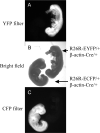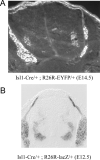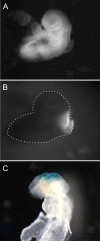Cre reporter strains produced by targeted insertion of EYFP and ECFP into the ROSA26 locus
- PMID: 11299042
- PMCID: PMC31338
- DOI: 10.1186/1471-213x-1-4
Cre reporter strains produced by targeted insertion of EYFP and ECFP into the ROSA26 locus
Abstract
Background: Several Cre reporter strains of mice have been described, in which a lacZ gene is turned on in cells expressing Cre recombinase, as well as their daughter cells, following Cre-mediated excision of a loxP-flanked transcriptional "stop" sequence. These mice are useful for cell lineage tracing experiments as well as for monitoring the expression of Cre transgenes. The green fluorescent protein (GFP) and variants such as EYFP and ECFP offer an advantage over lacZ as a reporter, in that they can be easily visualized without recourse to the vital substrates required to visualize beta-gal in living tissue.
Results: In view of the general utility of targeting the ubiquitously expressed ROSA26 locus, we constructed a generic ROSA26 targeting vector. We then generated two reporter lines of mice by inserting EYFP or ECFP cDNAs into the ROSA26 locus, preceded by a loxP-flanked stop sequence. These strains were tested by crossing them with transgenic strains expressing Cre in a ubiquitous (beta-actin-Cre) or a cell-specific (Isl1-Cre and En1-Cre) pattern. The resulting EYFP or ECFP expression patterns indicated that the reporter strains function as faithful monitors of Cre activity.
Conclusions: In contrast to existing lacZ reporter lines, where lacZ expression cannot easily be detected in living tissue, the EYFP and ECFP reporter strains are useful for monitoring the expression of Cre and tracing the lineage of these cells and their descendants in cultured embryos or organs. The non-overlapping emission spectra of EYFP and ECFP make them ideal for double labeling studies in living tissues.
Figures




Similar articles
-
CRISPR/Cas9-mediated targeting of the Rosa26 locus produces Cre reporter rat strains for monitoring Cre-loxP-mediated lineage tracing.FEBS J. 2017 Oct;284(19):3262-3277. doi: 10.1111/febs.14188. Epub 2017 Sep 19. FEBS J. 2017. PMID: 28763160
-
Activation of EGFP expression by Cre-mediated excision in a new ROSA26 reporter mouse strain.Blood. 2001 Jan 1;97(1):324-6. doi: 10.1182/blood.v97.1.324. Blood. 2001. PMID: 11133778
-
Faithful activation of an extra-bright red fluorescent protein in "knock-in" Cre-reporter mice ideally suited for lineage tracing studies.Eur J Immunol. 2007 Jan;37(1):43-53. doi: 10.1002/eji.200636745. Eur J Immunol. 2007. PMID: 17171761
-
The color of mice: in the light of GFP-variant reporters.Histochem Cell Biol. 2001 Jan;115(1):49-58. doi: 10.1007/s004180000233. Histochem Cell Biol. 2001. PMID: 11219608 Review.
-
Tools and Techniques for Wt1-Based Lineage Tracing.Methods Mol Biol. 2016;1467:41-59. doi: 10.1007/978-1-4939-4023-3_4. Methods Mol Biol. 2016. PMID: 27417958 Review.
Cited by
-
Conditional deletion of IP3R1 by Islet1-Cre in mice reveals a critical role of IP3R1 in interstitial cells of Cajal in regulating GI motility.J Gastroenterol. 2024 Oct 30. doi: 10.1007/s00535-024-02164-1. Online ahead of print. J Gastroenterol. 2024. PMID: 39476178
-
Alpha- to Beta-Cell Transdifferentiation in Neonatal Compared with Adult Mouse Pancreas in Response to a Modest Reduction in Beta-Cells Using Streptozotocin.Int J Mol Sci. 2024 Oct 17;25(20):11152. doi: 10.3390/ijms252011152. Int J Mol Sci. 2024. PMID: 39456933 Free PMC article.
-
Interaction between subventricular zone microglia and neural stem cells impacts the neurogenic response in a mouse model of cortical ischemic stroke.Nat Commun. 2024 Oct 24;15(1):9095. doi: 10.1038/s41467-024-53217-1. Nat Commun. 2024. PMID: 39448558 Free PMC article.
-
Morphological, electrophysiological, and molecular alterations in foetal noncompacted cardiomyopathy induced by disruption of ROCK signalling.Front Cell Dev Biol. 2024 Oct 7;12:1471751. doi: 10.3389/fcell.2024.1471751. eCollection 2024. Front Cell Dev Biol. 2024. PMID: 39435333 Free PMC article.
-
Cell-cell interaction determines cell fate of mesoderm-derived cell in tongue development through Hh signaling.Elife. 2024 Oct 11;13:e85042. doi: 10.7554/eLife.85042. Elife. 2024. PMID: 39392396 Free PMC article.
References
-
- Rossant J, McMahon A. "Cre"-ating mouse mutants-a meeting review on conditional mouse genetics. Genes Dev. 1999;13:142–5. - PubMed
Publication types
MeSH terms
Substances
LinkOut - more resources
Full Text Sources
Other Literature Sources
Molecular Biology Databases
Research Materials

